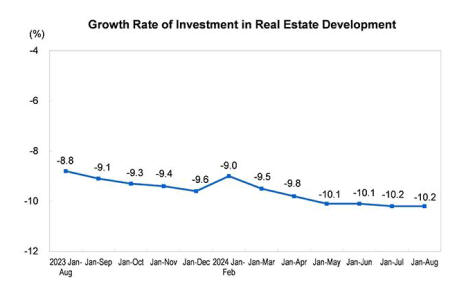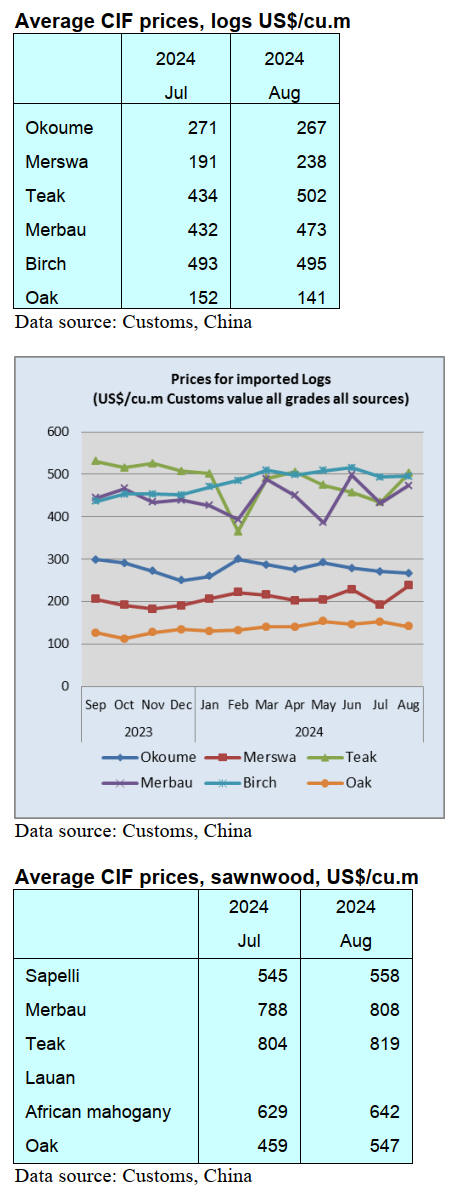US Dollar Exchange Rates of
10th
Oct
2024
China Yuan 7.06
Report from China
Investment in real estate development
The national Bureau of Statistics released details of real
estate investment between January and August indicating
there was year-on-year decrease of 10.2% in investment,
of which the investment in residential buildings was down
by 10.5%.

See:
https://www.stats.gov.cn/english/PressRelease/202409/t2024092
4_1956651.html
China to 'significantly increase' debt to revive growth
The Chinese economy faces strong deflationary pressures
due to a sharp real estate market downturn and frail
consumer confidence. A wide range of economic data in
recent months has missed forecasts, raising concerns that
the government's 4-5% growth target for this year may not
ne achieved.
See: https://www.channelnewsasia.com/east-asia/china-says-it-
will-significantly-increase-debt-revive-economic-growth-
4674346
In early October the government announced it will
"significantly increase" debt to revive the economy but is
yet to provide details of the package. At a press conference
the Finance Minister, Lan Foan, said the central
government will help local governments tackle their debt
problems, offer subsidies to people with low incomes,
support the property market and replenish state banks'
capital, among other measures.
A wide range of economic data in recent months has
missed forecasts, raising concerns that a longer-term
structural slowdown could emerge.
See: https://www.reuters.com/world/china/china-says-will-
significantly-increase-debt-revive-economic-growth-2024-10-12/
and
https://www.channelnewsasia.com/east-asia/china-says-it-will-
significantly-increase-debt-revive-economic-growth-4674346
Revised national standards
14 national standards related wood products have been
released recently in China. These standards are:
GB/T 44689-2024: Odor classification and evaluation
method for Wood-based panel and products
GB/T 44690-2024 Volatile organic compound release
classification for wood-based panels and products
GB/T 23472-2024 Impregnated film paper veneer straw
board
GB/T 30364-2024 Reconstituted bamboo flooring
GB/T 44290-2024 Method for calculating biochar content
in wood and wood products
GB/T 17664-2024 Charcoal
GB/T 44346-2024 Wood activated carbon identification
method
Increased log imports from US
According to China Customs, log imports from US rose
4% to 1.5 million cubic metres between January and
August 2024, surging 60% in July 2024.
North American hardwoods, Douglas fir and oak log
imports from the US rose 30%, nearly 400% and 41%
respectively in July 2024.
The main reason for increase was that China extended
tariff exemptions on hardwood logs and sawnwood
imported from US from 1 August 2024 to the end of
February 2025.
This policy update means that until the end of February
2025 US timber suppliers will not be subject to the tariffs
imposed by China. By extending the tariff exclusion
period the import cost of related wood is expected to
remain unchanged which is conducive to stabilising
market expectations, providing a stable market
environment for North American wood importers in
today's complex and changeable international trade
environment and greatly promoting the rapid development
of Sino-US wood trade.
Surge in sapelli imports
According to China Customs, between January and July
2024 China’s sapelli imports surged over 140% to 56,000
cubic metres valued at US$31 million, jumping over 140%
over the same period of 2023.
Monthly data on China’s sapelli imports were affected by
seasonal factors and China’s Spring Festival holiday,
China’s sapelli sawnwood imports suffered a brief trough,
down 14% in the following months.
In March 2024 import volumes of sapelli sawnwood
increased 260% year-on-year which became a turning
point in the growth of imports up to July 2024. In May,
sapelli sawnwood imports reached a peak, up to 12,600
cubic metres, an increase of nearly 200% year on year.
However, after June the growth rate of imports fell sharply
but it was still 57% higher than the same period last year.

Cameroon and the Republic of Congo were the largest and
the second largest suppliers of China’s sapelli imports.
93% of China’s sapelli imports were shipped from the two
countries between January and July 2024.
China’s sapelli imports from Cameroon and the Republic
of Congo amounted to nearly 31,000 cubic metres and
21,000 cubic metres, surging over 150% and 120% year
on year and accounted for 55% and 37% of the national
total.
The strong performance of sapelli sawnwood in China’s
domestic market recently benefited from a combination of
factors. Sapelli wood is widely used in furniture,
architecture and musical Instruments. It is currently
favored by Chinese consumers. The steady growth of the
market demand for sapelli wood has promoted a
significant increase in its imports.
In addition, reduced export prices and a significant
increase in the output by exporting countries have jointly
promoted the rapid growth of China's sapelli sawnwood
imports.
Growth of wood-based panel industry
The development of China's wood-based panel industry in
2023 was generally stable. According to a 2023 statistical
report on China's wood-based panel industry total
production capacity of the wood-based panel secor was
about 335 million cubic metres, up 2.2% year on year. The
output value of wood-based panel products was about
RMB764 billion, an increase of 15% year on year. The
consumption of wood-based panel products was about 318
million cubic metres, an increase of 10% year on year.
In addition to Beijing, Tianjin, Shanghai, Tibet, Qinghai,
Ningxia, the remaining 25 provinces had wood-based
panel production in 2023. Eight provinces had a
production of more than 10 million cubic metres.
Production growth in Central and South China regions was
noted with Guangxi exceeding Shandong to become
China's largest wood-based panel production province.
At the end of 2023 there were more than 10,100 wood-
based panel manufacturers in China, down 17% year-on-
year.
Through the continuous promotion of supply-side
structural reform the structure of China's wood-based
panel industry has accelerated its adjustment, low
production capacity has been eliminated and enterprises
that have lost competitiveness have ceased operation.
Although the number of wood-based panel enterprises has
decreased, the average production capacity of enterprises
is steadily improving and new production lines were
mostly large-scale and technologically advanced.
In order to enhance market share and drive the
development of wood-based panel enterprises the scale of
top enterprises continued to expand. By the end of 2023
there are nearly 235 large-scale wood-based panel
production enterprises and enterprise groups. As of August
2024 there were 12 wood-based panel manufacturers with
a total production capacity of more than 1 million cubic
metres, of which 5 enterprises have a production capacity
of more than 2 million cubic metres per year.
The total import and export volume of China's wood-based
panels was 15.75 million cubic metres in 2023, an increase
of 1.2%; The total value of imports and exports was
US$6.761 billion, down 15% year-on-year.
China still is the major supplier of wood-based panels but
in the context of the overall global trade China's wood-
based panel industry needs to overcome many challenges.
Rise in wood product imports through Lanshan Port
It has been reported that up to July this year 6.678 million
cubic metres of wood was imported through Lanshan Port,
up 19% (log imports 6.566 million cu.m., sawnwood
imports 112,000 cubic metres), accounting for 17.5% of
China’s wood imports.
The wood industry in Lanshan District, Rizhao City,
Shandong Province has become the largest integrated
industrial base for log imports, processing and distribution.
Lanshan Port imported 9.656 million cubic metres of
wood (9.306 million cubic metres of logs, 350,000 cubic
metres of sawnwood), accounting for 15% of the national
total wood imports, accounting for 25% of the national
total log imports.
At present, there are more than 400 wood trade and
processing enterprises in Lanshan District (87 timber
enterprises with more than RMB20 million of an annual
main business incomes), with RMB12 billion of an annual
trade and processing output value and 7 large-scale
centralised processing zones with an annual wood
processing capacity of 6 million cubic metres, directly
supporting around 20,000 employees.
GGSC – China report
In August the People's Bank of China held a conference
seeking a more vigorous push for financial support to
facilitate large-scale equipment upgrades and the trade-ins
of bulk durable consumer goods.
In addition, the conference emphasised the prevention and
resolution of financial risks in the real estate sector and the
effective implementation of a 300-billion-yuan (about
US$42 billion) relending facility to support government
subsidised housing.
Also in August the National Bureau of Statistics released
data on the total retail sales of consumer goods which
showed that from January to July China's furniture retail
sales totalled 85.1 billion yuan (about US$12 billion),
representing a year-on-year increase of 2%.
August is generally a dull month for sales by China's
timber sector and in the south of the country
the duration and volume of rainfall exceeded that of
previous years which further impacted wood processing
and domestic sales.
In August the GTI-China index registered 43.1%, a
decrease of 0.4 percentage point from the previous month
and was below the critical value (50%) for 4 consecutive
months
As for the eleven sub-indexes, two indices (inventory of
main raw materials and delivery time) were above the
critical value of 50% while the remaining nine indices
(production, export orders, new orders, existing orders,
inventory of finished products, purchase quantity,
purchase price, import and employees) were all below the
critical value.
Compared to the previous month, the indices for existing
orders, purchase quantity, purchase price and inventory of
main raw materials increased by 0.5-4.7 percentage points.
The index for new orders was unchanged from the
previous month and the indices for production, export
orders, inventory of finished products, import, employees,
and delivery time declined by 0.4-5.7 percentage points
See: https://www.itto-
ggsc.org/static/upload/file/20240929/1727586546173092.pdf
 
Through the eyes of industry
The latest GTI report lists the challenges identified by the private
sector in the Republic of Congo and Gabon.
See: https://www.itto-
ggsc.org/static/upload/file/20240929/1727586546173092.pdf
|